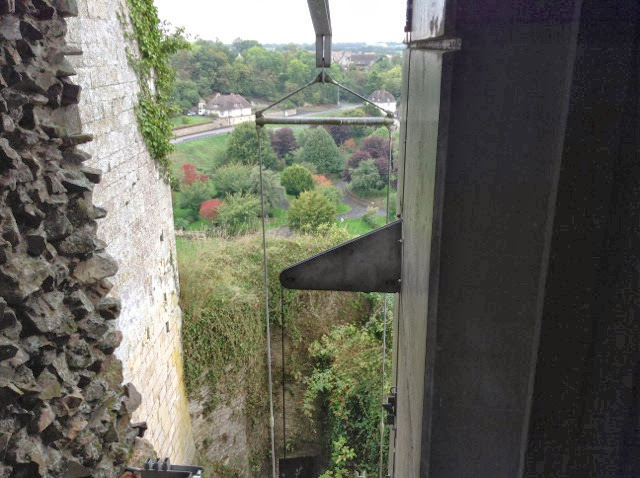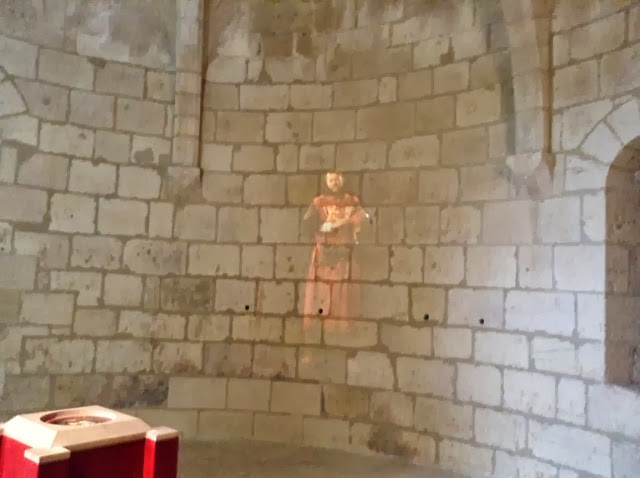After visiting Bayeux in Normandy to see the one thousand year old Bayeux tapestry, which tells the story of William the Conqueror's victory at the Battle of Hastings in 1066, we were highly motivated to drive to Falaise to visit his castle.
The Bayeux tapestry and Falaise Castle proved to be two of the many highlights of our trip.
The ancient tapestry, which is not really a tapestry but an embroidery of wool stitched on linen, is 69 metres long and about 50 cm wide and is displayed behind glass in a completely darkened gallery.
For an object of such age, it is in amazingly good condition having benefited from excellent restorations.
I really encourage you have a look at this link to see some of the images portrayed on the tapestry.
Bayeux Tapestry (English)
The tapestry tells the story we all heard in our childhood, via story books or at school.
Edward the Confessor, King of England is old and ill and without heirs. He decides his French cousin William, Duke of Normandy should be his heir. He sends Harold, Duke of Wessex to France to advise William of his inheritance. Harold has an adventurous time in France - he is held hostage by a rival duke, he joins William in battle against the king of France and he rescues Norman soldiers from the quicksand at Mont Saint-Michel. On his return to England, King Edward dies and Harold seizes power for himself. William is not happy! He decides to invade England. His preparations are detailed in the tapestry as is his landing on English soil. The Battle of Hastings is depicted in great detail - Normans invading, Saxons defending. During the battle William's horse is killed and he must raise his visor to prove to his men that he is still alive. Harold is mortally wounded with an arrow in his eye. The Normans are victorious and William is the conqueror of the Saxons and claims their crown - King of England."
Remember it?

This is the entrance to Falaise castle where William was born in 1027, only son to the Duke of Normandy and the daughter of a tanner. He was called William the Bastard and was raised by his mother. He became Duke of Normandy at the age of nine, when his father died returning from the crusades.
His older cousins tried to remove William from the dukedom and he spent his teenage years fighting to gain control of his inheritance. His victory in taking Falaise castle by force sealed his power over Normandy. He was aged about nineteen.
"The strategic site of Falaise castle bears witness to great Anglo-Norman power, from William the Conqueror to his sons Richard the Lionheart (good King Richard) and John Lackland (bad King John).
His third son, Henry Beauclerc was born in England following the Norman conquest in 1066. As heir to both the Dukedom of Normandy and the Crown of England, King Henry 1 totally transformed his father's former castle. Around 1123 he had a great square keep built similar to those he had seen his father, the Conqueror build in England to secure the rights and properties of the new Norman lords.
Falaise is one of France's rare examples of Anglo-Norman architecture", although there are many examples in England.

Falaise is one of France's rare examples of Anglo-Norman architecture", although there are many examples in England.

Most of us probably think that a castle was a castle - one single building with a drawbridge out the front and a moat all around!
But a castle was actually a strategically positioned, small, fortified village. So it covered a very large area and every aspect along the walls needed to be defended. It also needed to be able to withstand siege, so it needed to have its own sources of water and food.
Looking down from the highest point of the castle, you can see the external walls, the dry moats and the new information centre. There are two garden areas on the centre-right of the photo: one was the village vegetable garden and the other was a contemplation garden attached to the church that stood here within the castle grounds.
To the left of this central wall is the new inforation centre, built on the site of, and using stone from a nobleman's house that existed on this spot, within the castle grounds. The square building on the right is the highly fortified part of the castle where the duke resided. It is the part that had the drawbridge and greater fortification.
The square keep built by William's son, Henry Beauclerc, Henry 1 of England, to reinforce a weakness in the wall defences.
The main castle was square with some additional round towers. The holes in the old wall are where wooden structures were once attached. In times of siege, these wooden structures were destroyed to remove opportunities to scale the walls.
This is the only restoration we have seen where modern materials have been used to replace missing sections. In this case, rectangular grey stone and concrete has been used to re-form the facade. The main drawbridge together with internal drawbridges have been remade in aluminium checquerplate.
In this restoration, all of the steps, walkways, gates, bridges that would have originally been made of wood, have been reconstructed in stainless steel. It must have cost an arm and a leg but it looks absolutely fabulous.
This drawbridge/gate and set of steps to a stone gateway would have originally been made of wood - they are now stainless steel.
Part of the drawbridge winching mechanism.
Looking out through the stainless steel crenelations above the front drawbridge, towards the information centre.
Once inside the main castle we were incredibly impressed by the displays. This was an electronic family tree for William the Conqueror, displayed across a huge wall. It was linked into a commentary on the audio guide as well as .........
.... these ghostly projections.
Meet my friend William the Conqueror, talking to me, personally, telling me his story.
A few years ago, the people who look after Falaise castle (I must admit to not knowing their correct title) received a grant for a fabulously innovative project. They engaged a group of professional actors, as well as a professional script-writer and a film director. Inside the castle they filmed soliloquies for each character (about 20) who were part of the story of Falaise: William the Conqueror, his descendants, his friends and his enemies.
Each visual soliloquy is projected onto a wall and resembles a ghostly presence, telling you about themselves and the part they played in the history of Falaise, of France and of England. It was fantastic!
In addition to the 'ghosts', we had iPad rather than a traditional audio guide. In each reconstructed room of the castle, we were instructed to focus the camera of the iPad over a central medallion which loaded data onto the iPad providing a three dimensional recreation of each room, showing its original decoration and the purposes for which it was used. Quite unique - we have never seen technology applied to historical monuments in this way before. Entrance, iPad and 4 hours of history all for the princely sum of 6 euros ($8.40) each.
In this room it was Richard the Lionheart who was speaking to me. Richard's castle is only about 70 kilometres away - I must put it on the itinerary. Richard is such a romantic character because of the stories of Robin Hood, Sherwood forest, the Sheriff of Nottingham, bad King John (Richard's brother and William the Conqueror's son) and the crusades.
On the rear wall you can almost see the ghosts of Phillipe August, King of France and Eleanor of Acquitane, deliberating the future of France through a game of chess.
Weapons. By focussing the iPad camera on the medallion in front of each model, we were treated to facts and figures about the weapon, the physics of how it worked and a demonstration of it in action. Complete with sound affects!
William on his war horse. Alas it was raining heavily at this point and I wasn't willing to get drenched trying to get a better photo of the big W.
























No comments:
Post a Comment